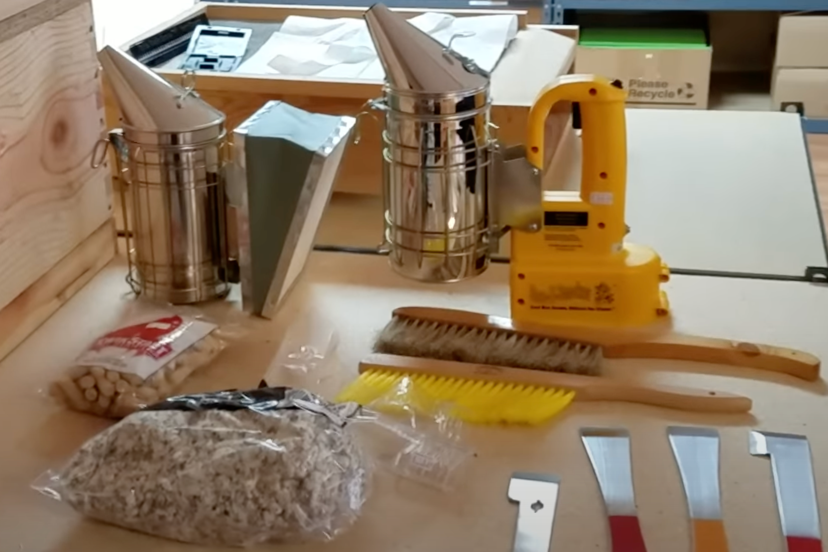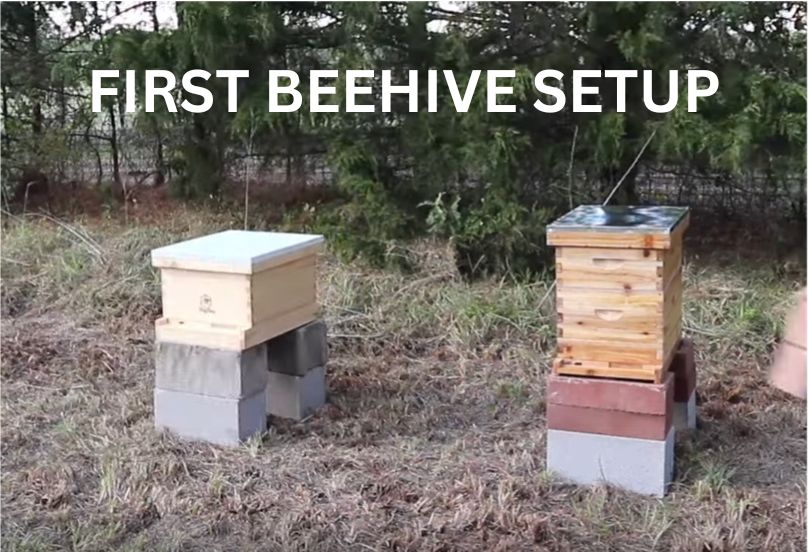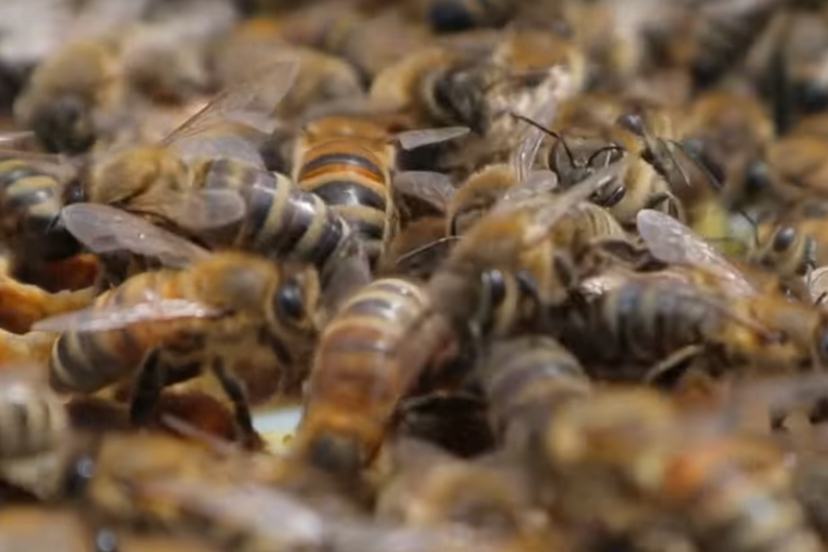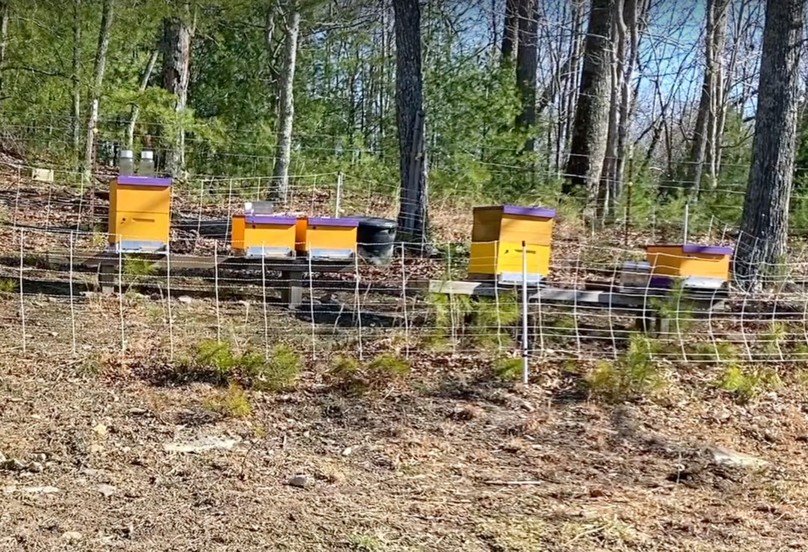Welcome, bee enthusiasts and honey hopefuls! So, you’ve decided to jump into the sweet world of beekeeping? Fantastic! But before you don your bee suit, let’s talk about the pitfalls that many new-bees make that can turn your apiary dreams into a sticky (and often expensive) situation.

Did you know that even experienced beekeepers sometimes make rookie mistakes? It’s true! Don’t be too hard on yourself. A survey found that 94% of new beekeepers make at least one major mistake in their first year. But don’t worry, we’re here to help you avoid becoming a statistic.
In this guide, we’ll explore the top 10 beekeeping blunders and show you how to sidestep them faster than a bee avoids rain. So, grab your smoker (not too close to the curtains, please) and let’s dive in!
- 1. Location, Location, Location: Hive Placement Pitfalls
- 2. The Inspection Infection: Overdoing Hive Checks
- 3. Feeding Faux Pas: Nutrition Nightmares
- Neglecting To Adjust Feeding For Seasons
- 4. Queen Conundrums: Royal Mismanagement
- 5. Mite Might: Underestimating Varroa
- 6. Space Race: Improper Hive Management
- 7. Winter Woes: Cold Weather Calamities
- 8. Equipment Errors: Gear And Gadget Gaffes
- 9. Record-Keeping Rebellion: Documentation Disasters
- Overlooking The Value Of Seasonal Notes
- 10. The Social Sting: Neighborhood Neglect
- Ignoring Local Beekeeping Regulations
- The Final Buzz:
1. Location, Location, Location: Hive Placement Pitfalls
Let’s talk about finding the perfect bee crib. Because in the world of bees, location is everything – get it wrong, and you’ll be the proud owner of the insect equivalent of a haunted house.
Choosing The Wrong Spot For Your Hive
First up, choosing the wrong spot for your hive. It’s like trying to sell a beach house in the middle of a desert – your bees won’t be impressed. Plop that hive in a damp, shady corner, and you might as well hang up a “Mold and Mildew B&B” sign.
Put it too close to human traffic, and you’ll be staging impromptu reenactments of “The Swarm” every time you mow the lawn.

Ignoring Sun Exposure And Wind Protection
Now, let’s chat about sun exposure and wind protection. Ignoring these is like sending your bees to live in a combination sauna and wind tunnel. Too much sun? Congratulations, you’ve just created a bee-sized oven.
Your little buzzers will be fanning themselves harder than a Southern belle at a summer picnic. Not enough sun? Welcome to the bee version of a damp, chilly basement apartment. As for wind protection, unless you’re trying to train Olympic bee windsurfers, give those hives some shelter!
Forgetting About Water Sources
And oh, the water sources. Forget about these, and you’ll have bees doing long-distance flights just for a sip. It’s like building a house with no plumbing – inconvenient and slightly smelly.
Your bees need water closer than the neighbor’s koi pond (trust me, that’s a conversation you don’t want to have). No nearby water? Congrats, you’re now running a bee marathon training camp.
Remember, a well-placed hive is a happy hive. Get it right, and your bees will be singing your praises in whatever language bees use. Get it wrong, and well… let’s just say angry bees are a lot less forgiving than angry Yelp reviewers.
So channel your inner bee feng shui master and choose wisely. Your bees (and your non-swollen ankles) will thank you!
2. The Inspection Infection: Overdoing Hive Checks
Let’s talk about your budding career as a hive paparazzi. Because nothing says “I love my bees” quite like checking on them every five minutes, right? Wrong!
Disturbing The Hive Too Frequently
Disturbing the hive too frequently is like repeatedly poking a sleeping bear – eventually, you’re going to get more than you bargained for. Your bees are trying to run a tight ship here, not host an open house.
Every time you crack that lid, it’s like a tiny bee apocalypse. “The sky is falling! Quick, rebuild everything!” Give them some space, helicopter apiarist!
Not Using Smoke Properly During Inspections
Not using smoke properly during inspections is like trying to calm a toddler with an air horn. Too little smoke, and you’re essentially ringing the dinner bell for an all-you-can-sting buffet.
Too much, and you’re hosting a bee rave. Neither scenario ends well for you or your docile honey-makers.
Misinterpreting Normal Bee Behavior
Last but not least, misinterpreting normal bee behavior. This is like thinking your cat’s dead because it’s napping in a weird position. See a bunch of bees hanging out front of the hive? No, they’re not planning a coup; they’re probably just hot. Hearing a loud buzz?
It’s not a bee rock concert; it might just be orientation flights. Not every little bee quirk is a five-alarm emergency requiring your immediate, panic-stricken intervention.
Remember, a good beekeeper is like a good parent – attentive but not smothering. Your bees have been doing this whole survival thing for millions of years. They’ve got this. Your job is to support, not micromanage their every buzz and wiggle.
So put down that hive tool, step away from the smoker, and let your bees be bees. They’ll thank you for it by not turning your next inspection into a scene from a horror movie. Now, if you’ll excuse me, I need to go check on my hives for the 47th time today. Do as I say, not as I do!
3. Feeding Faux Pas: Nutrition Nightmares
Let’s talk about the culinary catastrophes of the apiary world. Because nothing says “I love my bees” quite like turning their hive into a combination of a all-you-can-eat buffet and a starvation diet, right?
Overfeeding Or Underfeeding Your Bees
Overfeeding or underfeeding your bees is like trying to raise a teenager – too much, and they get lazy and entitled; too little, and they’re hangry all the time.
Overfeed, and suddenly your bees are the insect equivalent of couch potatoes, wondering why they should bother with flowers when Room Service keeps bringing the good stuff. Underfeed, and you’ll have a hive full of bees giving you the stink eye every time you walk by. Trust me, bee side-eye is not something you want to experience.
Using The Wrong Type Of Feed
Now, let’s talk about using the wrong type of feed. This is like serving a gourmet chef a microwave dinner and expecting applause. Brown sugar in your syrup? Congratulations, you’ve just opened a bee laxative stand. Honey from an unknown source?
You might as well be playing Russian roulette with bee diseases. Your bees have standards, folks. They’re not going to be impressed by your bargain-bin bee cuisine.
Neglecting To Adjust Feeding For Seasons
And oh, the seasonal adjustments. Neglecting to adjust feeding for seasons is like wearing a parka in summer and a bikini in winter. Your bees need different nutrition at different times of the year. Spring calls for light syrup to mimic nectar, while fall demands the thick stuff to prep for winter.
Ignore this, and you’ll be running a bee summer camp when you should be prepping for bee hibernation (yes, I know bees don’t actually hibernate, but “winter cluster” doesn’t have the same ring to it).
Remember, feeding your bees is an art form, not a food-flinging free-for-all. Get it right, and you’ll have a hive of happy, productive bees. Get it wrong, and… well, let’s just say angry, malnourished bees are not known for their forgiveness or their honey production.
So put on your chef’s hat, grab that bee-feeding cookbook, and let’s turn your hive into a five-star bee restaurant. Just don’t expect any Michelin stars – bees are notoriously stingy with their reviews.
4. Queen Conundrums: Royal Mismanagement
Alright, bee monarchy managers, let’s dive into the royal drama of the hive world. Because nothing spices up beekeeping quite like a little royal intrigue, right?
Failing To Recognize Queen Problems
Failing to recognize queen problems is like being the last to know about royal scandals. Your hive’s got more drama than a soap opera, and you’re sitting there thinking, “Everything’s fine!” Meanwhile, your queen’s laying eggs in a pattern that looks more like abstract art than a proper brood nest.
Wake up and smell the royal jelly, folks! A bad queen can turn your hive into the insect version of a ghost town faster than you can say “colony collapse.”
Improper Queen Introduction Techniques
Now, let’s talk about improper queen introduction techniques. This is not a royal wedding; you can’t just toss a new queen in there and expect a happily ever after. That’s a recipe for a bee coup d’état. Imagine being introduced to your new boss by having them suddenly appear in your living room.
Awkward, right? Same for bees. You need finesse, patience, and maybe a little Barry White music to set the mood. (Okay, maybe not that last part.)
Overlooking The Importance Of Queen Genetics
Overlooking the importance of queen genetics is like ignoring your family’s medical history. Sure, that queen might look great on paper, but if her genes are about as robust as a wet paper bag, you’re in for a world of hurt.
Good genetics mean better disease resistance, higher honey production, and bees that are less likely to turn your backyard into a scene from “The Birds.”
Remember, your queen is the heart and soul of the hive. Treat her right, and your colony will be buzzing with joy. Mess it up, and you’ll be dealing with more bee drama than a hive-themed reality TV show.
So put on your royal beekeeper crown, brush up on your queen-rearing skills, and let’s turn your hive into a thriving monarchy. Just don’t let the power go to your head – no one likes a tyrant, especially not bees with stingers.
5. Mite Might: Underestimating Varroa
Alright, bee defenders, it’s time to talk about the bogeyman of the bee world – Varroa mites. These tiny terrors are like miniature vampires hosting an all-you-can-suck buffet in your hive.
Ignoring Mite Monitoring And Treatment
Ignoring mite monitoring and treatment is like pretending the weird noise in your car will go away if you turn up the radio. Spoiler alert: it won’t. While you’re humming along, blissfully unaware, these mites are turning your hive into the insect version of a horror movie. Before you know it, your bees will be doing the “Thriller” dance, and not in a good way.
Using Ineffective Or Harmful Treatments
Now, let’s chat about using ineffective or harmful treatments. This is like trying to put out a fire with gasoline because it’s liquid, right? Wrong! Some treatments are about as effective as throwing confetti at the mites and yelling “Boo!”
Others might kill the mites but leave your bees wishing they’d taken their chances with the vampires. Do your research, or you’ll be hosting a bee funeral instead of a mite eviction.
Misunderstanding Mite Life Cycles
Misunderstanding mite life cycles is like thinking babies come from storks. Cute, but dangerously misinformed. These little nasties have a complex life cycle that would make a soap opera writer’s head spin.
If you don’t know your mite facts, you’ll be playing whack-a-mole while they’re playing chess. And trust me, in this game, you don’t want to be the mole.
Remember, Varroa mites are the ultimate party crashers, and your hive is the hottest club in town. Your job is to be the bouncer, keeping these unwanted guests out. Get it right, and your bees will be dancing (or waggling) with joy. Get it wrong, and… well, let’s just say “post-apocalyptic bee wasteland” doesn’t look good on a honey label.
So strap on your mite-fighting gear, study up on your Varroa vittles, and let’s turn your hive into Fort Knox for bees. Just remember, in the world of mites, paranoia isn’t just a good idea – it’s a survival strategy!
6. Space Race: Improper Hive Management
Let’s talk about the delicate art of bee real estate management. Because nothing says “I have no idea what I’m doing” quite like a hive that’s either bursting at the seams or echoing with emptiness.
Adding Supers Too Late Or Too Early
Adding supers too late or too early is like trying to put pants on a toddler – timing is everything. Too late, and your bees will be packed tighter than sardines in a can, plotting their great escape.
Too early, and they’ll be rattling around in there like the last pea in a can, wondering if they took a wrong turn at Albuquerque. You’ve got to be the Goldilocks of beekeeping – everything needs to be juuuust right.
Neglecting To Manage Swarming Impulses
Now, let’s address the elephant in the room – or should I say, the swarm in the tree. Neglecting to manage swarming impulses is like ignoring your teenager’s request for a later curfew. Sooner or later, there’s going to be a rebellion.
One day you’re admiring your thriving hive, the next you’re watching half your bees reenact the opening scene of a nature documentary. “And here we see the majestic bee swarm, leaving their confused beekeeper behind…”
Overcrowding Or Under-Populating Hives
Overcrowding or under-populating hives is a delicate balance. It’s like hosting a party – too many guests and it’s uncomfortable, too few and it’s just sad. Overcrowd, and you’ll have bees filing workplace complaints about violation of personal space.
Under-populate, and your bees will be holding “We’re Hiring” signs at the hive entrance. Neither scenario ends well for honey production or bee morale.
Remember, managing hive space is like being a bee city planner. You need to anticipate growth, manage population density, and keep everyone happy. Get it right, and you’ll have a thriving bee metropolis. Get it wrong, and you’ll be dealing with everything from bee traffic jams to mass bee exodus.
So grab your bee zoning permit (aka your hive tool), put on your urban planner hat, and let’s turn your hive into the most desirable bee real estate in town. Just don’t get any bright ideas about charging rent – bees are notoriously bad at handling money.
7. Winter Woes: Cold Weather Calamities
it’s time to talk about keeping your buzzers cozy when Jack Frost comes knocking. Because nothing says “oops” quite like a hive full of bees doing their best imitation of frozen TV dinners.
Inadequate Winter Preparations
Inadequate winter preparations are like sending your bees on an Arctic expedition in flip-flops and a tank top. “It’s just a little chilly,” you say, while your bees are frantically knitting tiny scarves and cursing your name in bee language.
Remember, winter for bees isn’t about cute sweaters and hot cocoa – it’s survival of the fittest (and the best prepared).
Moisture Mismanagement In The Hive
Now, let’s dive into the swampy world of moisture mismanagement. Turning your hive into a bee sauna might sound cozy, but trust me, it’s not. Too much moisture in a winter hive is like hosting a wet t-shirt contest in freezing temperatures – uncomfortably damp and potentially deadly. Your bees will be less “chillin'” and more “chilled to the bone.”
Disturbing Bees During Cold Months
And for the love of honey, stop disturbing bees during cold months! It’s like waking a bear mid-hibernation – risky, pointless, and likely to end with someone getting hurt (spoiler: it’s probably you).
Every time you pop that lid for a “quick peek,” you’re letting out precious heat faster than a teenager sneaking out of the house.
Winter beekeeping is like being a combination of a meteorologist, an insulation expert, and a ninja. You need to predict the weather, prep the hive, and then become invisible until spring. Get it right, and your bees will emerge in spring ready to conquer the world. Get it wrong, and… well, let’s just say “beekeeping” might become “bee-mourning.”
So bundle up that hive, manage that moisture, and resist the urge to play peek-a-boo with your bees. Your colony’s winter survival depends on it. And who knows? With the right preparation, your bees might even send you a thank-you note come spring. (Okay, they won’t, but a beekeeper can dream, right?)
8. Equipment Errors: Gear And Gadget Gaffes
Let’s talk about the hardware of beekeeping. Because nothing says “I have no idea what I’m doing” quite like showing up to your hive with a salad fork and a good attitude.
Using Poor Quality Or Inappropriate Equipment
Using poor quality or inappropriate equipment is like trying to change a tire with a spoon. Sure, you might eventually get the job done, but at what cost to your sanity (and your spoon)?
That bargain bin bee suit might seem like a steal until you’re doing the “bee in my bonnet” dance across your backyard. And that hive tool from the dollar store? Let’s just say it’s all fun and games until someone loses a thumb.
Neglecting Equipment Maintenance
Neglecting equipment maintenance is like ignoring that check engine light on your car. Sure, it’ll probably be fine… until it’s not, and you’re stranded on the side of the road with a hive full of angry bees and a smoker that’s about as useful as a chocolate teapot.
Overspending On Unnecessary Gadgets
On the flip side, we have the overenthusiastic gadget collectors. Overspending on unnecessary gadgets is like buying a submarine for your goldfish bowl. Do you really need that electric nectar collector with built-in WiFi? Unless your bees are posting honey production updates on Instagram, probably not. Just because they make it doesn’t mean you need it.
The key is finding that sweet spot between “MacGyver with a paperclip” and “Batman with his utility belt.” You want to be prepared, not weighed down by more gadgets than Best Buy on Black Friday.
Good beekeeping is about understanding your bees, not having the fanciest toys on the block. Invest in quality where it matters, maintain your gear like your life depends on it (because sometimes, it does), and resist the urge to buy every shiny new bee gadget that catches your eye.
So, put down that bee-themed watering can (unless you’re gardening, in which case, carry on), step away from the electric honey stirrer, and let’s focus on the essentials. Your bees – and your wallet – will thank you.
9. Record-Keeping Rebellion: Documentation Disasters
Let’s talk about the thrilling world of hive record-keeping. I can feel your excitement already! Because nothing says “I’m a serious beekeeper” quite like a notebook full of chicken scratches and honey stains.
Failing To Keep Accurate Hive Records
Failing to keep accurate hive records is like trying to write your memoirs with a goldfish memory. “Did I treat for mites last month or was that my plan for next year?”
Congratulations, you’ve just turned your beekeeping journey into a mystery novel, and you’re the confused protagonist. Without good records, you’re basically playing “Guess Who?” with your hives every time you pop the lid.
Not Tracking Queen Performance Or Lineage
Not tracking queen performance or lineage is like forgetting your family tree at a reunion. Suddenly, you’re calling Aunt Bertha “Mom” and wondering why everyone’s giving you strange looks. Your queen’s performance history is the 23andMe of your hive.
Without it, you’re just guessing whether Her Royal Highness is a productive monarch or a royal pain in the thorax.
Overlooking The Value Of Seasonal Notes
Overlooking the value of seasonal notes is like ignoring the weather forecast and then being surprised when it rains on your picnic. Those little observations about which plants the bees preferred in spring or how they handled that August heatwave?
That’s golden information, my friend. It’s the difference between being a bee psychic next year and feeling like you’re starting from scratch every season.
Good record-keeping is like being the narrator of your own beekeeping reality show. It’s not always exciting, but it sure makes the plot twists easier to handle. Plus, it’s way more reliable than trying to decipher the waggle dances for last month’s nectar sources.
So grab that notebook, dust off your best doctor’s handwriting, and start documenting like your honey harvest depends on it (because it kind of does). Who knows? You might just write the next great American bee novel. “Fifty Shades of Honey,” anyone?
10. The Social Sting: Neighborhood Neglect
It’s time to talk about the symphony of neighborhood beekeeping. Because nothing says “I’m a fantastic neighbor” quite like a surprise swarm of bees crashing the block party.
Ignoring Local Beekeeping Regulations
Ignoring local beekeeping regulations is like deciding stop signs are just friendly suggestions. Sure, it’s all fun and games until you’re explaining to Officer Friendly why your apiary looks more like a bee metropolis than the quaint little hobby you promised the zoning board. “But officer, I thought the ‘two hives max’ rule was more of a guideline!” Good luck with that one, cowboy.
Failing To Communicate With Neighbors
Failing to communicate with neighbors about your new hobby is like setting up a drum kit at 2 AM and wondering why everyone looks grumpy in the morning.
Surprise! Not everyone appreciates waking up to find their prized petunias have become an all-you-can-eat buffet for your flying friends. A little heads up goes a long way – maybe throw in some honey bribes while you’re at it.
Mishandling Swarms Or Escaped Bees
Mishandling swarms or escaped bees is the beekeeping equivalent of yelling “Food fight!” in a crowded cafeteria and then ducking out the back door.
Suddenly, your quiet suburban street is reenacting scenes from “The Swarm,” and guess who’s the star of this disaster flick? That’s right, it’s you, the beekeeper who thought they could handle a little swarm action solo. Spoiler alert: you can’t.
Being a good beekeeper isn’t just about keeping your bees happy – it’s about keeping your neighbors from forming an angry mob with pitchforks and bee veils. It’s a delicate balance of diplomacy, education, and sometimes, flat-out bribery (honey works wonders, trust me).
So brush up on those local laws, practice your “Hey neighbor, funny story…” speech, and maybe invest in some swarm-catching equipment that doesn’t look like it was cobbled together from your kid’s old Halloween costume. Your bees, your neighbors, and your reputation will thank you.
And who knows? Play your cards right, and you might just become the neighborhood honey hero instead of the local menace. Just don’t let it go to your head – no one likes a smug beekeeper, especially one covered in stingers.
The Final Buzz:
Congratulations, you’ve just graduated from the School of Hard Knocks (without the actual knocks)! Armed with this knowledge, you’re now ready to tackle the world of beekeeping with the confidence of a bee doing the waggle dance.
Remember, every great beekeeper was once a beginner, and mistakes are just opportunities for honey-sweetened learning. Keep these tips in mind, stay observant, and don’t be afraid to ask for help from more experienced beekeepers.
Before you know it, you’ll be the one giving advice to wide-eyed newbies. So go forth, tend to your bees, and may your hives be ever prosperous and your honey ever sweet!




